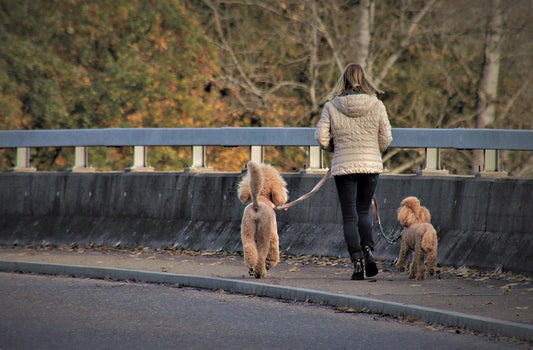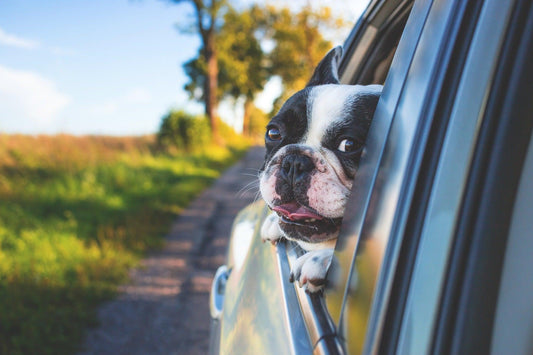It is a common problem that many dog owners encounter: your dog pulls on the leash while walking. It can be an annoying and sometimes even dangerous situation, both for you and for your dog. But don't worry, in this article we'll discuss how to train your dog not to pull on the leash while walking. We'll discuss different training methods and techniques, as well as tools you can use to make the process go more smoothly.
Why does a dog pull on a leash?
Before we get into training methods, it's important to understand why a dog pulls on a leash. There are several reasons why a dog may exhibit this behavior:
- Excitement - Dogs may pull on a leash because they are excited to discover new smells, meet other dogs or simply to release some energy.
- Fear and Uncertainty - Dogs may pull on a leash out of fear or uncertainty, such as when encountering something scary or threatening.
- Hunting Instinct - Some dogs have a strong hunting instinct and can therefore pull on the leash to chase prey.
How to train your dog not to pull on the leash
There are several ways to train your dog not to pull on the leash. Here are some techniques you can try:
- Basic commands - Make sure your dog knows basic commands like "sit," "stay," and "here." This will form the basis of your training.
- Rewards - Use rewards to reinforce positive behaviors. Reward your dog with a treat or pat on the head when he doesn't pull on the leash.
-
Clicker Training - Use a clicker to train your dog
learn what behavior is desired. Click and reward your dog when he doesn't pull on the leash. 4. Loose-leash walking - Practice walking your dog relaxed on a loose leash. This means that the belt is slack and not tight.
Training Methods
Now that you know the basics, let's dig deeper into specific training methods for teaching your dog not to pull on a leash:
- Stop - If your dog starts to pull, stop walking and wait for the leash to loosen. Only when your dog stops pulling can you continue walking. This teaches your dog that pulling won't get him anywhere.
- Turn around - When your dog pulls on the leash, suddenly turn around and walk the other way. This will teach your dog to follow you instead of dragging you along.
- Speed Up and Slow Down - Vary your walking pace to keep your dog alert and focused. Walk sometimes faster and sometimes slower so that your dog learns to adapt to your pace.
Tools for training
There are also several tools available that you can use to train your dog not to pull on the leash:
- Head Collars and Harnesses - Special collars and harnesses are designed to prevent dogs from pulling on the leash. These can be helpful in training your dog, but it's important to use them properly and not hurt your dog.
- Long leashes - Long leashes give your dog more freedom of movement, helping you train him to walk a greater distance from you without pulling on the leash.
Patience and persistence
Training your dog not to pull on a leash takes time and patience. It is important to be consistent in your training and not to give up. Keep in mind that the training process is different for every dog and some dogs learn faster than others. Be patient and persevere, and you will eventually see results.
Conclusion
Training your dog not to pull on the leash while walking is essential for a relaxed and enjoyable walking experience. By understanding why your dog pulls and using different training methods and tools, you can successfully teach your dog to walk relaxed on a loose leash. Remember that patience and persistence are the keys to success in training your dog.
Frequently Asked Questions
-
How long does it take to train my dog not to pull on the leash?
It varies per dog how long it takes to learn or unlearn this behavior. Some dogs learn quickly, while others take longer. Be patient and stay consistent in your training.
-
My dog is a bit older, can I still train him not to pull on the leash? Yes, it's never too late to teach your dog new behaviors. While training an older dog may take a little more time and patience, it is certainly possible to train an older dog not to pull on a leash as well.
-
Can I train my puppy not to pull on the leash, or should I wait until he's older? You can certainly start training your puppy not to pull on the leash. In fact, it's a good idea to start teaching good behavior as early as possible. Keep in mind, however, that puppies are still developing and their attention spans are shorter than adult dogs.
-
My dog only pulls on the leash when he sees other dogs, what can I do? In this case, your best bet is to work on improving your dog's focus on you. Practice with your dog paying attention to you, even in the presence of other dogs. You can do this by rewarding your dog for looking at you, or by using special commands such as "look at me" or "focus."
-
Do I need to use a special collar or harness to train my dog not to pull on the leash? While special collars and harnesses can be helpful in training your dog, they are not always necessary. The most important thing is to be consistent in your training and work on reinforcing the desired behavior. However, if you find yourself having trouble controlling your dog, a special collar or harness can help you better control the pulling behavior.




